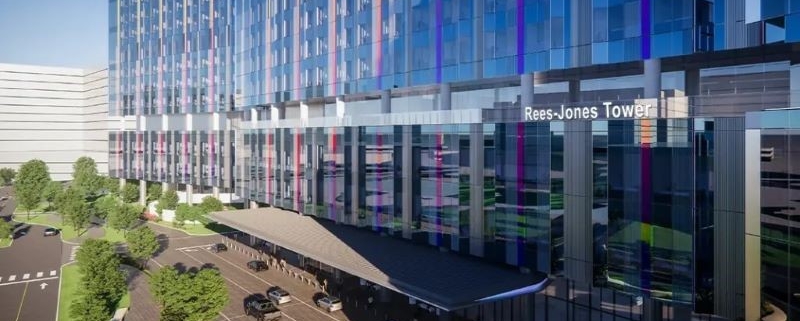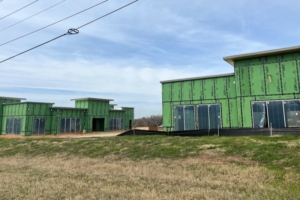When it comes to children’s health, can you have too much of a good thing?
That’s worth asking after two leading health systems announced they’re building big children’s facilities in Prosper, near the Dallas North Tollway and U.S. Highway 380. The two projects, about 35 miles north of downtown Dallas, are just 3 miles apart.

Cook Children’s of Fort Worth plans to build a hospital in Prosper, just 3 miles from an even larger project planned by Children’s Health of Dallas. (PHOTO CREDIT: Cook Children’s Health)
Cook Children’s, whose flagship hospital is in downtown Fort Worth, unveiled plans for a hospital on April 25, hours after Children’s Health in Dallas announced plans for a new campus on 72 acres.
While the additions would greatly increase the offerings in specialized pediatric care, that’s just the half of it. About 8 miles to the south in Frisco, Texas Scottish Rite Hospital for Children opened in October. Not far away, there’s Children’s Medical Center Plano, which opened in 2008.
With the two latest expansions, there would be four children’s facilities within 8 miles of Frisco City Hall. For some context, the entire Dallas metro region had four children’s hospitals for years: Cook’s in Fort Worth and three in Dallas: Children’s, Scottish Rite and Medical City Children’s.
Will this new competition help reduce health care costs in North Texas, which are among the highest in the country? Or will it drive up spending because hospital companies must recoup their investments one way or another? And what does it say about the priorities of two respected nonprofits devoted to improving the health of kids?
Each system has billions in assets, hundreds of millions in cash and strong profit margins at its flagship hospitals. What they’re doing is following the money — and the families with good insurance coverage.
“The economics are driving this, not health care public policy,” said Britt Berrett, a former hospital administrator who teaches health care management at the University of Texas at Dallas.
The companies are also tracking population growth. From 2016 to 2018, Frisco added over 20,000 residents, a 14% increase, according to a report by Moody’s Investors Service. Frisco’s property tax collections, a reflection of the area’s rising wealth, grew 24% over the same period, far faster than in Dallas and Fort Worth.
But Frisco, Plano and the surrounding area have many hospitals already, including recent additions such as Baylor, Scott and White’s sports therapy center and Texas Health Frisco. Last year, Medical City Plano started a $107 million patient tower with 90 beds.
So what to think about putting four children’s facilities in such a concentrated area?
“We call it saturation,” said Berrett, a past president of Texas Health Presbyterian Hospital Dallas. “Beware the medical industrial complex.”
Executives at both Children’s Health and Cook Children’s were not available to talk about such issues, according to the companies’ spokeswomen.
“Unfortunately, schedules did not align to arrange an interview for your story,” wrote Children’s Health in an email. The company included a statement about “serving patients in the fast-growing area around Prosper and our mission to make life better for children.”
That’s a noble mission, to be sure, but it’s still fair to ask whether the new investment is more about protecting market share from Cook Children’s, which is clearly reaching beyond its usual customers. Neither company would disclose how much it plans to spend. Children’s Health wouldn’t even confirm it’s building another hospital on the site, although its rendering appears to have a big one.
Texas does not require a “certificate of need” to add hospitals or nursing home beds. It lets the market decide, which means booming, affluent areas get more attention and investment.
In an email, a Cook Children’s spokeswoman said the administrators “best fit to speak about this” were out of town. She requested questions in writing — and some answers were less than direct.
So are we building too many children’s facilities in the area?
“We see a growing and unmet need plus a lack of coordinated care for the children in this important service area, which Cook Children’s will accommodate through its expansion plans,” wrote Nancy Cychol, chief of hospital services.
Will there be enough demand to recruit specialists, such as pediatric heart surgeons, and to develop true centers of excellence?
“Cook Children’s is very thoughtful in evaluating all relevant market information to determine where to locate services and the scope of services offered,” Cychol wrote.
Children’s Health and Cook are nearly the same size. Both have over 7,500 employees, and reported over $1.7 billion in 2018 revenue and over $3 billion in assets, including gifts from donors.
One big difference: Children’s in Dallas had twice the share of Medicaid patients, whose payments for care tend to be much lower than customers with private health insurance.
Cook’s operating income was nearly $139 million last year, 63% higher than Children’s, according to the companies’ annual financial filings.
“Most children’s hospitals have great leverage with insurers because they almost always have to be included in employers’ network of providers. They offer expensive specialized care that isn’t available elsewhere, and they can get a premium for primary care,” said industry analyst Allan Baumgarten. “The big buildup near Prosper raises several questions and the most important is: “Who’s gonna pay for this new capacity?” In states that require regulatory approval for new hospitals, some proposals were rejected with the support of employers that feared they would have to cover much of the bill.”
How would Cook’s respond if local players — worried about rising health prices — pushed back on its plan?
“We don’t believe employers or insurance companies would ever object to competition in the marketplace,” wrote Cook’s Cychol, “especially if the competition drives better value, better quality and convenient, coordinated care.”
Presumably, that’s at any price.
Source: Dallas News






